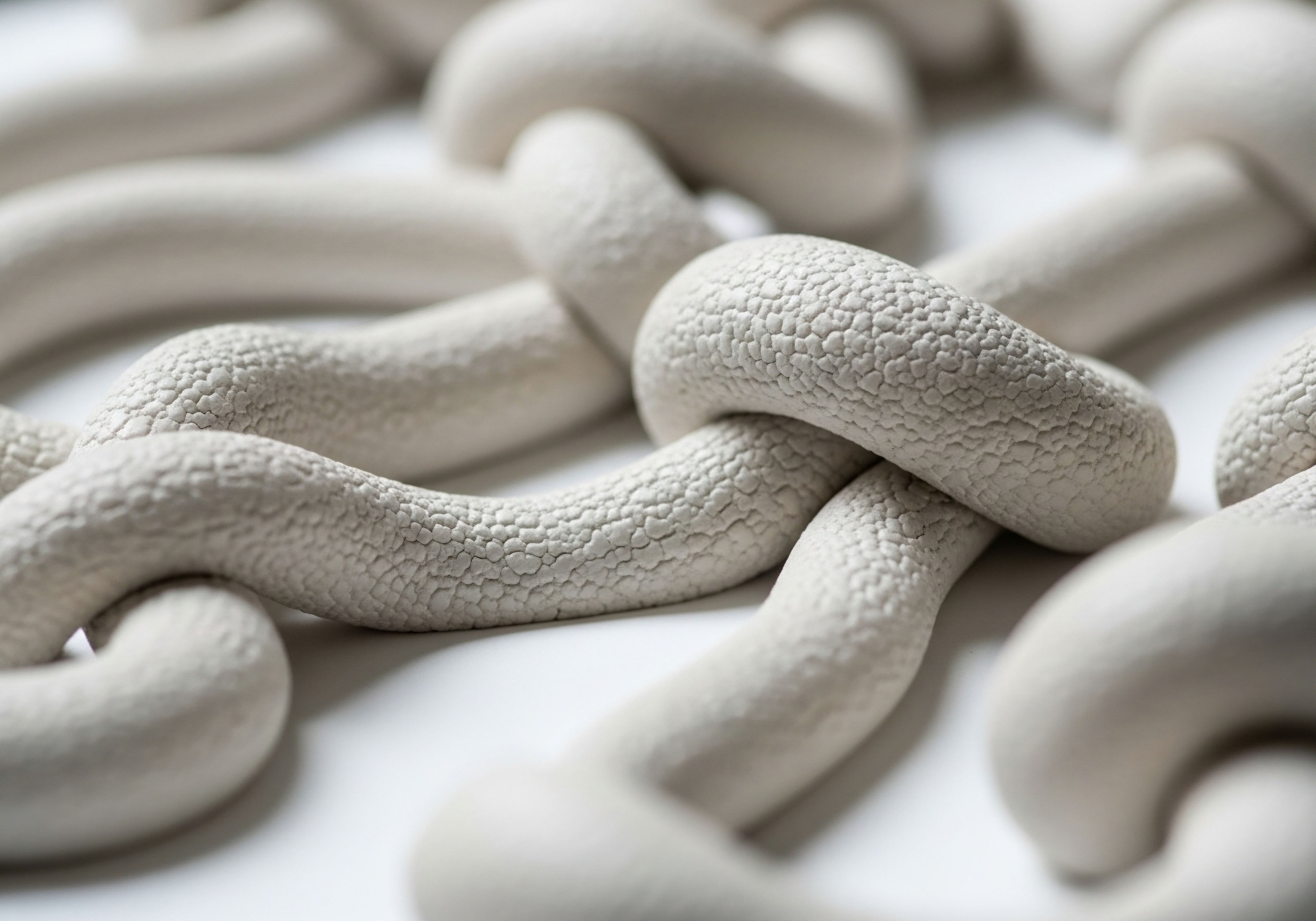

Fundamentals
The feeling is a familiar one for many. It manifests as a subtle dimming of vitality, a persistent fatigue that sleep does not resolve, a noticeable decline in physical strength, or a quiet fading of ambition and drive. These experiences are not abstract complaints; they are tangible signals from your body’s intricate communication network, the endocrine system.
When we ask if dietary changes alone can restore optimal testosterone levels, we are truly asking about the power of nutrition to recalibrate this entire system. The answer begins with understanding that your hormones are not manufactured from thin air. They are synthesized from the very nutrients you consume. Your body is a biological factory, and your diet provides the essential raw materials.
Every meal is an instruction, a set of data that informs your physiology. The production of testosterone, a steroid hormone, is fundamentally dependent on the availability of specific building blocks, primarily cholesterol derived from dietary fats. The communication system that governs this production, the Hypothalamic-Pituitary-Gonadal (HPG) axis, is exquisitely sensitive to your nutritional status.
The hypothalamus, acting as the command center, releases gonadotropin-releasing hormone (GnRH) in precise pulses. This signals the pituitary gland to secrete luteinizing hormone (LH), which then travels to the Leydig cells in the testes, instructing them to produce testosterone. This entire cascade relies on a foundation of adequate energy and micronutrient availability. A deficit in either can disrupt the signaling, slow the production line, and lead to the symptoms you may be experiencing.

The Foundational Role of Macronutrients
Your body’s hormonal architecture is built upon the three pillars of macronutrients ∞ fats, proteins, and carbohydrates. Each plays a distinct and critical role in supporting the endocrine system, and a deficiency or imbalance can have cascading effects on testosterone production.

Dietary Fat the Precursor to Hormones
Dietary fat is perhaps the most direct nutritional contributor to testosterone synthesis. Cholesterol, often viewed negatively, is the essential precursor molecule from which all steroid hormones, including testosterone, are derived. Research consistently shows that diets overly restrictive in fat can lead to a reduction in circulating testosterone levels.
A systematic review and meta-analysis of intervention studies confirmed that men on low-fat diets experienced significant decreases in total and free testosterone. This underscores the importance of consuming adequate healthy fats from sources like avocados, olive oil, nuts, and seeds to provide the foundational substrate for hormone production.

Protein the Structural Component
Proteins are composed of amino acids, which are the building blocks for nearly every structure in the body, including the receptors that hormones bind to and the enzymes that facilitate their synthesis.
While protein intake itself is not a direct driver of testosterone production in the same way as fat, inadequate protein can lead to muscle loss and a catabolic state, which is generally suppressive to the HPG axis. Furthermore, some research suggests that the balance between macronutrients matters; for instance, replacing protein calories with saturated fat has been associated with modest increases in testosterone, highlighting the intricate relationship between these dietary components.

Carbohydrates the Energy Signal
Carbohydrates are the body’s primary energy source. A state of chronic low energy availability, which can occur with very low carbohydrate intake or severe caloric restriction, sends a powerful signal to the hypothalamus that the body is under stress and it is not an ideal time for metabolically expensive processes like reproduction.
This can lead to a downregulation of the HPG axis and reduced testosterone output. Consuming sufficient carbohydrates from complex sources like vegetables, tubers, and whole grains helps maintain glycogen stores and signals to the body that there is enough energy available to support robust endocrine function.
Your diet is the foundational environment from which your entire hormonal system is built and maintained.

Essential Micronutrients the Catalysts of Production
While macronutrients provide the building blocks and energy, micronutrients ∞ vitamins and minerals ∞ act as the essential catalysts and cofactors in the complex biochemical reactions of hormone synthesis. Deficiencies in specific micronutrients can create significant bottlenecks in the testosterone production pathway, even when macronutrient intake is sufficient.
Think of these micronutrients as the specialized tools and skilled labor in your body’s hormonal factory. Without them, the assembly line grinds to a halt. Three of the most well-documented and critical micronutrients for male endocrine health are Vitamin D, Zinc, and Magnesium.
- Vitamin D ∞ Often called the “sunshine vitamin,” Vitamin D functions more like a steroid hormone in the body. Receptors for Vitamin D are found in the hypothalamus, pituitary gland, and testes, indicating its direct role in regulating the HPG axis. Studies have shown a strong correlation between Vitamin D deficiency and low testosterone levels, with supplementation in deficient men leading to significant increases in testosterone.
- Zinc ∞ This essential mineral is a critical cofactor for hundreds of enzymes, including those involved in testosterone synthesis. Zinc deficiency has been shown to directly impair testosterone production, and supplementation in zinc-deficient individuals can restore levels. It plays a role in the conversion of cholesterol to testosterone and also helps regulate the function of the pituitary gland in releasing LH.
- Magnesium ∞ Magnesium is involved in over 300 enzymatic reactions in the body, including those related to energy metabolism and protein synthesis. Research indicates that magnesium intake is positively associated with testosterone levels, possibly by reducing the impact of oxidative stress and inflammation, both of which can suppress testosterone production. It may also help increase the bioavailability of testosterone by reducing its binding to Sex Hormone-Binding Globulin (SHBG).
Understanding these foundational principles is the first step. Recognizing that your fatigue, low mood, or decreased performance could be linked to the specific nutrients on your plate is an empowering realization. It shifts the perspective from one of passive suffering to one of active participation in your own biological recalibration. The question then evolves from if diet can help, to how it can be strategically implemented to provide the precise signals your body needs.


Intermediate
Moving beyond the foundational building blocks, we can begin to appreciate the endocrine system as a dynamic, responsive network governed by complex feedback loops. The question of restoring optimal testosterone through diet alone becomes a matter of systemic influence.
It requires an understanding of not just what to eat, but how dietary patterns and overall metabolic health regulate the sensitive machinery of the Hypothalamic-Pituitary-Gonadal (HPG) axis. Here, we transition from viewing food as mere raw material to understanding it as a powerful modulator of biological communication.
The body’s hormonal state is a reflection of its perceived environment. Chronic caloric deficits, excessive body fat, and systemic inflammation are all powerful signals that can disrupt the precise, pulsatile release of hormones that drive testosterone production. Addressing these systemic issues through targeted dietary strategies is the core principle of using nutrition as a primary intervention.
This approach recognizes that low testosterone is often a symptom of a broader metabolic imbalance, a condition sometimes referred to as functional hypogonadism. In such cases, the testes are capable of producing testosterone, but the signals from the brain are being suppressed by these larger systemic pressures.

The Caloric Equation Energy Availability and Hormonal Signaling
The human body is fundamentally wired for survival. When it perceives a state of chronic energy deficiency, it initiates a series of adaptations to conserve resources. One of the first systems to be downregulated is the reproductive axis, as it is metabolically expensive and not essential for immediate survival. This is a key reason why severe or prolonged caloric restriction can significantly suppress testosterone levels.
The hypothalamus acts as the primary energy sensor in this context. When energy intake is consistently too low, the pulsatile release of GnRH becomes blunted. This reduction in signaling frequency and amplitude means the pituitary gland receives a weaker and less frequent instruction to produce LH.
Consequently, the Leydig cells in the testes receive less stimulation, and testosterone production declines. This is a protective mechanism, but in the context of modern dieting, it can lead to the very symptoms individuals are trying to resolve through weight loss. A sustainable dietary protocol must therefore provide sufficient energy to support both metabolic function and endocrine health.
Severe caloric restriction sends a survival signal to the brain that can actively suppress the hormonal cascade required for testosterone production.

Body Composition the Adipose Tissue as an Endocrine Organ
The relationship between body fat and testosterone is a critical, bidirectional one. While low testosterone can contribute to fat accumulation, excess adipose tissue, particularly visceral fat, actively suppresses testosterone production through several mechanisms. This creates a self-perpetuating cycle that can be difficult to break.

Aromatase Activity and Estrogen Conversion
Adipose tissue is a primary site of the enzyme aromatase, which converts testosterone into estradiol, a form of estrogen. In individuals with excess body fat, elevated aromatase activity leads to an increased conversion of testosterone to estrogen.
The resulting higher estrogen levels send a negative feedback signal to the hypothalamus and pituitary, further suppressing the production of GnRH and LH, and thus reducing the initial production of testosterone. A dietary strategy aimed at improving testosterone must therefore focus on reducing excess body fat to decrease this aromatase-driven hormonal conversion.

Inflammation and Adipokines
Visceral fat is metabolically active and secretes a variety of signaling molecules, including inflammatory cytokines (like IL-6 and TNF-alpha) and adipokines (like leptin). Chronic low-grade inflammation, a hallmark of obesity, has been shown to have a direct suppressive effect on both the hypothalamus and the Leydig cells.
Pro-inflammatory cytokines can interfere with GnRH release and directly inhibit the testosterone-producing machinery within the testes. Elevated leptin levels, common in obesity, can also disrupt HPG axis signaling. Therefore, a successful dietary intervention must be inherently anti-inflammatory, focusing on whole, unprocessed foods rich in antioxidants and omega-3 fatty acids.
The table below outlines the key mechanisms through which excess body fat impacts testosterone and the corresponding dietary goals.
| Mechanism of Suppression | Biological Process | Primary Dietary Goal |
|---|---|---|
| Increased Aromatase Activity |
Conversion of testosterone to estradiol in fat cells, leading to negative feedback on the HPG axis. |
Reduce overall body fat percentage through a sustainable caloric deficit and nutrient-dense diet. |
| Chronic Systemic Inflammation |
Secretion of inflammatory cytokines (e.g. IL-6, TNF-alpha) from visceral fat, which directly suppresses hypothalamic and testicular function. |
Incorporate anti-inflammatory foods (e.g. fatty fish, berries, leafy greens) and minimize processed foods, sugar, and industrial seed oils. |
| Leptin and Insulin Resistance |
Disrupted signaling from the adipokine leptin and impaired insulin sensitivity interfere with normal HPG axis communication. |
Improve insulin sensitivity through controlled carbohydrate intake, increased fiber, and regular physical activity. |

What Are the Most Effective Dietary Architectures?
While no single “testosterone diet” exists, certain dietary frameworks are more conducive to creating a favorable metabolic and hormonal environment. The focus should be on nutrient density, blood sugar stability, and healthy fat intake.
- Mediterranean-Style Diet ∞ This pattern is rich in monounsaturated fats from olive oil, omega-3 fatty acids from fish, and a wide array of antioxidants and polyphenols from fruits, vegetables, and nuts. Its emphasis on whole foods and anti-inflammatory components makes it an excellent framework for supporting metabolic health and, by extension, endocrine function.
- Paleo or Whole-Foods Diet ∞ By eliminating processed foods, refined sugars, and industrial seed oils, these approaches naturally reduce the inflammatory load on the body. They emphasize high-quality protein, healthy fats, and nutrient-dense carbohydrates from vegetables and fruits, aligning well with the nutritional requirements for hormone production.
- Moderate-Carbohydrate, High-Fat Approach ∞ As established, very low-fat diets can suppress testosterone. Conversely, ensuring adequate fat intake, including sources of monounsaturated and some saturated fats, provides the necessary precursors for steroidogenesis. A meta-analysis found that low-fat diets were associated with decreases in testosterone levels, particularly in men of European descent. A diet that avoids fat restriction is therefore structurally advantageous.
Ultimately, the goal of a dietary intervention is to shift the body from a state of metabolic stress (characterized by inflammation, insulin resistance, and high aromatase activity) to a state of metabolic efficiency. This systemic improvement creates the optimal internal environment for the HPG axis to function without suppression, allowing for the restoration of the body’s natural testosterone production capacity.


Academic
An academic exploration of dietary influence on testosterone requires moving beyond macronutrient ratios and into the molecular signaling pathways that govern androgen biosynthesis. The central question of whether diet alone can restore optimal levels hinges on the specific etiology of the hypogonadal state.
For individuals with functional hypogonadism secondary to metabolic dysregulation, the potential for dietary intervention is substantial. This is because the primary defect is not in the gonads themselves, but in the systemic environment that controls the Hypothalamic-Pituitary-Gonadal (HPG) axis. Here, we will dissect the intricate relationship between insulin resistance, systemic inflammation, and the regulation of Sex Hormone-Binding Globulin (SHBG), as these are the primary levers through which diet exerts its powerful, albeit indirect, effects.
The prevailing clinical reality is that a significant portion of the decline in male testosterone levels observed in Western nations is linked to the rising prevalence of obesity and type 2 diabetes. Male Obesity-Related Secondary Hypogonadism (MOSH) is a well-defined clinical entity where the pathology is driven by adipose tissue dysfunction. Therefore, a sophisticated dietary strategy is, in essence, a therapeutic intervention aimed at correcting the metabolic phenotype to restore endocrine homeostasis.

The Insulin-SHBG-Testosterone Connection
Sex Hormone-Binding Globulin (SHBG) is a glycoprotein produced primarily in the liver that binds to androgens and estrogens in the bloodstream, rendering them biologically inactive. Only the unbound, or “free,” testosterone is available to bind to androgen receptors and exert its physiological effects. Consequently, total testosterone levels can be misleading if SHBG is abnormally high or low. One of the most powerful regulators of hepatic SHBG production is insulin.
In a state of hyperinsulinemia, a hallmark of insulin resistance and metabolic syndrome, chronic high levels of insulin directly suppress the synthesis of SHBG in the liver. This leads to lower circulating levels of SHBG.
While this might initially seem to increase free testosterone, the same metabolic state that causes hyperinsulinemia (namely, obesity and inflammation) also suppresses total testosterone production at the level of the HPG axis. The net result is often low total testosterone with inappropriately “normal” or low SHBG, leading to a significant reduction in bioavailable androgen.
A dietary intervention that improves insulin sensitivity ∞ typically by managing carbohydrate load, increasing fiber, and promoting weight loss ∞ can reverse this process. As insulin levels normalize, the liver resumes normal production of SHBG, which is a marker of improved metabolic health. While this may increase the binding of testosterone, the concurrent reduction in inflammatory and aromatase-related suppression often leads to a greater overall increase in total testosterone production, resulting in a net positive effect on free testosterone levels.
The regulation of SHBG by insulin provides a direct molecular link between dietary carbohydrate management and the bioavailability of testosterone.

Inflammatory Cytokines as Direct Gonadotoxins
The characterization of obesity as a state of chronic, low-grade inflammation has profound implications for testicular function. Adipose tissue, particularly visceral depots, functions as an endocrine organ that secretes a host of pro-inflammatory cytokines, including Tumor Necrosis Factor-alpha (TNF-α) and Interleukin-6 (IL-6). These molecules are not passive bystanders; they are active endocrine disruptors.
Research has demonstrated that these cytokines can exert suppressive effects at all three levels of the HPG axis:
- Hypothalamic Suppression ∞ TNF-α and IL-1β can inhibit the release of Gonadotropin-Releasing Hormone (GnRH) from the hypothalamus, reducing the primary signal that initiates the entire androgen production cascade. This is a central mechanism in inflammation-induced hypogonadism.
- Pituitary Suppression ∞ IL-6 has been shown to blunt the response of pituitary cells to GnRH, meaning that even if the hypothalamic signal is sent, the pituitary’s release of Luteinizing Hormone (LH) is impaired.
- Testicular Suppression ∞ Perhaps most directly, TNF-α and other cytokines can act as gonadotoxins, directly inhibiting steroidogenesis within the testicular Leydig cells. They interfere with the enzymatic steps that convert cholesterol into testosterone, effectively poisoning the local production factory.
A diet designed to restore testosterone must therefore be fundamentally anti-inflammatory. This involves more than simply adding antioxidants; it requires the systematic removal of pro-inflammatory dietary triggers (such as refined sugars, industrial trans fats, and omega-6-rich vegetable oils) and the aggressive inclusion of foods that modulate inflammatory pathways, such as sources of omega-3 fatty acids (EPA and DHA) and polyphenols.

Can Diet Overcome Primary Hypogonadism?
It is critical to differentiate between functional and classical hypogonadism. Dietary and lifestyle interventions show the most promise for functional hypogonadism, where the HPG axis is intact but suppressed. However, in cases of primary hypogonadism (testicular failure due to genetic conditions, injury, or medical treatments) or secondary hypogonadism caused by structural issues in the pituitary or hypothalamus (e.g.
a tumor), diet alone cannot restore normal function. In these scenarios, the hormonal production machinery is fundamentally broken or the command center is offline. While an optimal diet can support overall health and potentially improve the efficacy of hormonal optimization protocols like Testosterone Replacement Therapy (TRT), it cannot regenerate damaged Leydig cells or bypass a non-functioning pituitary gland. This is a crucial distinction in managing patient expectations and outlining a realistic therapeutic path.
The table below summarizes the classification of hypogonadism and the potential impact of dietary intervention.
| Type of Hypogonadism | Primary Defect Location | Typical Lab Findings (LH/FSH & T) | Potential for Dietary Restoration |
|---|---|---|---|
| Primary Hypogonadism |
Testes (Gonadal Failure) |
High LH/FSH, Low Testosterone |
Very Low. Diet supports general health but cannot fix the primary testicular defect. Hormonal therapy is typically required. |
| Secondary Hypogonadism |
Pituitary or Hypothalamus (Central) |
Low/Normal LH/FSH, Low Testosterone |
Low. If due to a structural issue (e.g. tumor), diet is supportive only. Hormonal therapy or treatment of the underlying cause is necessary. |
| Functional Hypogonadism (e.g. MOSH) |
Systemic (Metabolic Suppression) |
Low/Normal LH/FSH, Low Testosterone |
High. Diet is a primary therapeutic tool to alleviate the systemic suppression (inflammation, insulin resistance) on the HPG axis. |
In conclusion, the proposition that diet alone can restore optimal testosterone levels is scientifically plausible and clinically relevant, but only within the specific context of functional hypogonadism driven by metabolic disease. The intervention is not merely “eating healthy”; it is a targeted metabolic therapy aimed at reducing adiposity, improving insulin sensitivity, and quenching systemic inflammation.
By correcting these upstream pathological processes, a well-formulated dietary strategy allows the intrinsically healthy HPG axis to resume its normal, unsuppressed function. For individuals with primary or irreversible secondary hypogonadism, diet remains a vital component of a comprehensive health plan but cannot be expected to serve as a standalone cure.

References
- Whittaker, J. & Wu, K. (2021). Low-fat diets and testosterone in men ∞ Systematic review and meta-analysis of intervention studies. The Journal of Steroid Biochemistry and Molecular Biology, 210, 105878.
- Kataoka, S. et al. (2021). A review of foods and food supplements increasing testosterone levels. Journal of Men’s Health, 17(2), 6-16.
- Fui, M. N. Dupuis, P. & Grossmann, M. (2014). Lowered testosterone in male obesity ∞ mechanisms, morbidity and management. Asian journal of andrology, 16(2), 223 ∞ 231.
- Cangemi, R. et al. (2010). Long-term effects of calorie restriction on serum sex hormone concentrations in men. Aging Cell, 9(2), 236-242.
- Selvin, E. et al. (2007). The burden and treatment of diabetes in elderly adults in the U.S. ∞ a nationally representative study. Diabetes Care, 30(6), 1425-1430.
- Wrzosek, M. Włodarek, D. & Woźniak, J. (2018). The effect of zinc, magnesium and vitamin D on testosterone synthesis in men. Polish Journal of Sports Medicine, 34(3), 123-134.
- Calder, P. C. (2017). Omega-3 fatty acids and inflammatory processes ∞ from molecules to man. Biochemical Society Transactions, 45(5), 1105-1115.
- Corona, G. et al. (2020). Adipose tissue dysfunction and obesity-related male hypogonadism. Frontiers in Endocrinology, 11, 589.
- Fantus, R. J. Lokeshwar, S. D. & Ramasamy, R. (2020). The Association between Popular Diets and Serum Testosterone among Men in the United States. The Journal of Urology, 203(2), 398-404.
- Vingren, J. L. et al. (2010). Dietary fat and saturated fat are associated with resistance training-induced changes in free testosterone in college-aged men. International Journal of Sport Nutrition and Exercise Metabolism, 20(6), 520-529.

Reflection

Recalibrating Your Internal Environment
The information presented here provides a biological and clinical framework for understanding how the food you consume translates into hormonal function. The journey to reclaim vitality is deeply personal, and it begins with recognizing that your body is in constant communication with you through the symptoms you experience.
The fatigue, the mental fog, the loss of strength ∞ these are not character flaws. They are data points. They are signals from a complex, sophisticated system that is responding to its environment, an environment you have the power to change.
Consider the state of your own internal ecosystem. Is it one of chronic stress, inflammation, and metabolic burden, or is it one that is nourished, efficient, and resilient? The principles discussed are not a prescription, but a map. They offer a direction for how you might begin to shift that internal state by adjusting the inputs.
This knowledge empowers you to become an active participant in your own health narrative, to move from a position of reacting to symptoms to one of proactively cultivating the biological foundation for wellness. The path forward is unique to your physiology and your life, and this understanding is the first, most crucial step in navigating it with intention and purpose.



